New Material
New Material Industrial Park Project of Liaoyuan City
1 Introduction to the Project
1.1 Project background
1.1.1 Product introduction
The industrial park is a specific area in which the specific development entity plans the industrial positioning in a specific area, takes the land as the carrier, and attracts domestic and foreign-funded enterprises of specific types and specific industrial clusters by providing infrastructure such as housing construction and comprehensive supporting services, and produces agglomeration effects, enhances industrial competitiveness, and radiates to the periphery through a high degree of concentration of elements such as industry, capital, technology, and labor.
Industrial parks can be roughly divided into three categories: science and technology parks, general industrial parks, and professional parks according to their attributes; According to the bearing function, it can be divided into national development zones, provincial development zones and various professional parks; According to the development model, it can be divided into three types: government-led, enterprise-led, and government-enterprise cooperative development of industrial parks; According to the participants in the development and construction, it can be roughly divided into the industrial parks developed and constructed by government platform enterprises, professional developers, manufacturing entities, Internet enterprises and financial institutions.
Table 1 Classification of industrial parks
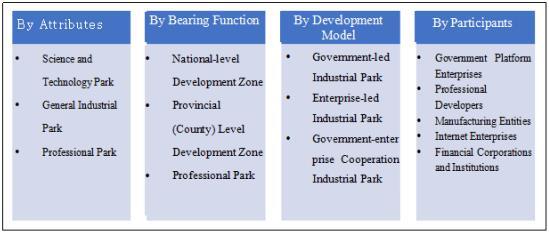
The project is planned to build a new material industrial park integrating raw material production, composite material processing and industrial product manufacturing in Liaoyuan Longshan Industrial Development Zone, relying on the basic advantages of Liaoyuan City's automobile industry, medical protection, air purification, textile and other industries, as well as the industrial agglomeration effect.
1.1.2 Market prospect
(1) The market prospect of the industrial park
At present, there are 696 national industrial parks in China; Among them, there are 230 state-level economic development zones, 178 high-tech zones, 171 special customs supervision zones, 19 border/cross-border cooperation zones, 22 national-level pilot free trade zones, 19 state-level new zones, 23 national independent innovation demonstration zones, and 25 other state-level industrial parks. Provincial industrial parks are approved by the governments of provinces, autonomous regions and municipalities directly under the central government, and the number of industrial parks has reached 2,133. In addition, China's municipal and county-level governments also have jurisdiction over tens of thousands of grassroots industrial parks, including general industrial parks, agricultural parks, etc.
In 2023, there were 54 industrial parks with a GDP of more than 100 billion yuan, an increase of 6 from the previous year. There were 67 industrial parks with more than 300 high-tech enterprises, an increase of 2 over the previous year, and 49 industrial parks with an import and export volume of more than 50 billion yuan, an increase of 9 over the previous year. At the same time, among the top 100 parks in 2023, there are 52 high-tech zones and 48 economic development zones. Among the top 1-30, the high-tech zone accounts for 17 seats, and the economic development zone accounts for 13 seats, and the high-tech zone has obvious advantages. Among the 71-100 in the tail, 18 seats are in the Economic Development Zone, 12 are in the High-tech Zone, and the Economic Development Zone accounts for a relatively large proportion.
Excellent industrial parks have complete industrial ecology and industrial aggregation development capabilities. They provide competitive enterprise supporting services and related facilities, and provide enterprises with a convenient office environment and a good industrial synergy mechanism.
Enterprises in the park form industrial clusters through industrial agglomeration, and enterprises can cooperate with each other, share resources, and promote technological innovation and knowledge sharing. By establishing a complete industrial ecosystem, industrial parks can attract more investment and enterprises to settle in, promoting the prosperity of the local economy and the improvement of innovation capabilities.
(2) Market prospect of new material industry
The new materials industry is an important part of the national strategic emerging industries and plays an important supporting role in realizing innovation-driven development. New materials are not only an important guarantee for the leading industries of the national economy, high-end manufacturing and national defense industries, but also the focus of international strategic competition in countries around the world. In recent years, with the acceleration of the global scientific and technological revolution and the increase in the research and development of new materials in various countries, China's new material industry has also ushered in unprecedented development opportunities. According to public data, from 2019 to 2022, the total output value of China's new materials industry increased from 4.5 trillion yuan to 6.7 trillion yuan, with a compound annual growth rate of 14.2%; In 2023, the total output value reached 7.9 trillion yuan. In 2025, the total output value of China's new materials industry is expected to exceed 10 trillion yuan. It is expected that in the next few years, with the rapid development of downstream application fields such as new energy vehicles, medical devices, biomedicine, and high-end equipment manufacturing, the market size of China's new material industry will continue to maintain a rapid growth trend.
The upstream of the industrial chain of the new materials industry is mainly the production and supply of raw materials, including but not limited to steel materials, non-ferrous metal materials, chemical materials, building materials, textile materials, etc., of which chemical materials include crude oil, coal, natural gas, chemical additives, monomer intermediates, etc. The midstream of the industrial chain is the R&D, manufacturing and production of new materials, covering a variety of new material types, including advanced basic materials, key strategic materials and cutting-edge new materials. These new materials are unique in terms of performance, function and application fields, and are widely used in many downstream industries. The downstream of the industrial chain covers many industries such as electronic information, new energy vehicles, energy conservation and environmental protection, home appliance industry, medical equipment, aerospace, textile machinery, construction and chemical industry.
Table 2 Structure of the new material industry chain
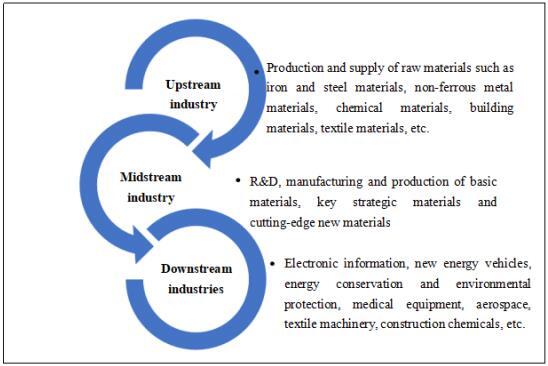
The investment boom in new materials has also benefited from the rapid development of downstream industries, especially the rapid growth of new energy vehicles, consumer electronics, semiconductors and other industries, which has promoted the increase in investment and the expansion of upstream material projects. For example, the application of carbon fiber composite materials in new energy vehicles, the application of special glass and advanced ceramics in the field of consumer electronics, and the application of silicon wafers and high-purity chemicals in the semiconductor industry.
China focuses on the development of three major categories of new materials, including advanced basic materials, key strategic materials and cutting-edge new materials. Each category contains specific subdivisions of new materials, with a wide range.
Table 3 Key development areas of China's new materials industry
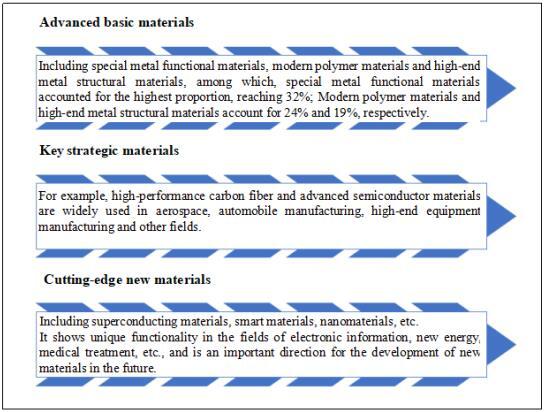
China's new material industry has formed a cluster development model, forming the distyribution of industrial clusters focusing on the Bohai Rim, the Yangtze River Delta and the Pearl River Delta, with outstanding characteristics in the northeast and central and western regions, constituting a spatial layout of “agglomeration in the eastern coastal area and characteristic development in the central and northeast regions”. The development and spatial distribution of the new material industry in each region have their own advantages and characteristics.
Table 4 The overall distribution of the core agglomeration areas of China's new material industry
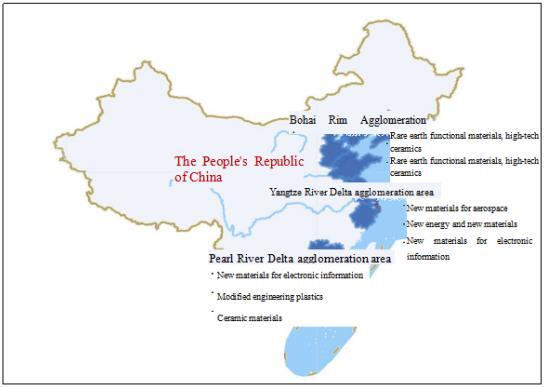
Beijing-Tianjin-Hebei region: The headquarters of large enterprises, top universities and key scientific research institutes in China are gathered, and the scientific and technological innovation capability is leading in China. It is a high-end new material industry cluster in China, focusing on the development of high-precision materials such as electronic information materials, new energy materials, biomedical materials, aerospace materials, high-performance membrane materials, and cutting-edge new materials.
Yangtze River Delta Region: The economy is relatively developed, the transportation is convenient, the industrial supporting facilities are perfect, and the new material industry cluster is the most, mainly developing high-performance metal materials, advanced polymer materials, high-performance fibers and other materials.
Pearl River Delta Region: The export-oriented economy is developed, the new material industry is highly concentrated, the application market is large, and it has strong advantages in the fields of electronic information materials, new chemical materials, and advanced ceramic materials.
Central Region: With a solid foundation in iron and steel, non-ferrous metals, chemicals, building materials and other traditional materials industry, through the development of deep processing products, Jiangxi Ganzhou new functional materials industry cluster, Hunan Zhuzhou cemented carbide material industry cluster, and Henan Zhengzhou superhard material industry cluster, etc. have been formed.
Western Region: The western region is rich in resources and energy, and relying on the advantages of resource transformation and key enterprises, it has gathered and formed a number of characteristic new material industrial bases in the fields of rare metal materials, new light alloys, and new energy materials.
Northeast Region: Northeast China has the advantages of bulk basic materials such as iron and steel chemical industry, and has a strong foundation for equipment manufacturing, gathering and developing high-end metal structural materials, advanced polymer materials and high-performance composite materials, forming Jilin carbon fiber industry cluster and Heilongjiang graphene industry cluster.
The Ministry of Industry and Information Technology said that the strength of China's new material enterprises is also gradually increasing. At present, there are more than 20,000 enterprises on the new material scale, more than 1,900 specialized and special new “little giant” enterprises, and more than 200 individual champion enterprises in the manufacturing industry. In addition, in the field of new materials, seven national advanced manufacturing clusters have been cultivated, which have become “accelerators” to promote regional economic growth.
Relying on the industrial foundation of high-precision aluminum and carbon fiber in Liaoyuan City, the project is planned to build a new material processing base for the automobile industry, medical protection, air purification, light textiles, etc., with broad market prospects.
1.1.3 Advantageous conditions of project construction
(1) Policy conditions
In December 2023, the Ministry of Industry and Information Technology issued the “Guidance Catalogue for the First Batch of Application Demonstration of Key New Materials (2024) Edition”, which mentions that it is necessary to focus on the application and promotion of three types of new materials: Advanced Basic Materials, Key Strategic Materials, and Cutting-Edge New Materials, covering 299 products, showcasing the latest achievements in materials science.
In January 2024, the “Implementation Opinions on Promoting the Innovation and Development of Future Industries” proposed: In the field of future materials, we will promote the upgrading of advanced basic materials such as non-ferrous metals, chemicals, and inorganic non-metals, develop key strategic materials such as high-performance carbon fiber and advanced semiconductors, and accelerate the innovative application of cutting-edge new materials such as superconducting materials.
The “14th Five-Year Plan” for the Development of Raw Material Industry proposes: Implement forward-looking layout actions for cutting-edge materials. Support scientific research units in working with enterprises, grasp the integrated development trend of new material technology and information technology, nanotechnology and intelligent technology, develop superconducting materials, intelligent bionics, additive manufacturing materials, etc., promote the systematic development of new backbone materials, and strengthen the support and guidance of application fields.
In 2020, the Office of the People's Government of Liaoyuan Municipality issued the “Implementation Measures for the Flexible Transfer of Industrial Land in Liaoyuan City (Trial) ”, proposing; The supply of industrial land by means of flexible term, lease before transfer, combination of lease and transfer, and long-term lease shall be supplied by means of bidding, auction and listing in accordance with the law; In principle, the flexible transfer period of industrial land shall be 10, 20, 30 and 40 years. Enterprises are allowed to voluntarily choose the term of land use right transfer during the period. The “Implementation Measures” not only reduce the cost of industrial land in Liaoyuan City, but also improve the land supply system of Liaoyuan City.
(2) Resource advantages
In recent years, Liaoyuan City has continued to optimize and adjust the energy structure, comprehensively launched the construction of a clean energy heating demonstration city in the north, and carried out 47 clean heating transformation projects such as “coal to gas” and “coal to electricity”, which is expected to reduce coal consumption equivalent to 510,000 tons of standard coal. In addition, Liaoyuan City is rich in wind, solar, biomass and other resources, which provides energy guarantee for the construction of the project.
(3) Industrial advantages
In terms of auto parts, at present, Liaoyuan City has 41 new energy auto parts related enterprises such as Gezhi Automobile, Hongtu Lithium Battery, Qixing Aluminum, etc., and 22 enterprises have been included in the FAW Group suppliers, forming a new energy auto parts supporting industrial system with key components of new energy vehicles as the core, traditional auto parts, lightweight automotive aluminum, and special vehicles as the support. In the fields of new energy vehicle power batteries and materials, drive motors, etc., it has been mass-produced, lightweight components such as aluminum alloy battery pack boxes, anti-collision beams and steel hot stamping parts have been produced on a large scale, and traditional auto parts such as vehicle pump assemblies, heavy-duty balance shaft assemblies and automotive molds are being upgraded and empowered at an accelerated pace. At the same time, in terms of lightweight automotive aluminum, it has benchmark enterprises such as Qixing Aluminum, Liyuan Refining, Jusheng Light Alloy, etc., mainly covering aluminum alloy profiles, plates, strips and foils and automotive lightweight products.
Liaoyuan rail passenger car industry has been developing for 20 years, and with the continuous upgrading of traditional industries, the output value of “high-precision aluminum + rail train profiles” increased by 15.4% year-on-year in 2023, accounting for 8% of the industry. Liaoyuan aluminum processing industry has completed the butterfly change from low value-added building profiles to high value-added industrial profiles.
Jilin Province has developed into one of the three major industrial bases of carbon fiber in China, and the advantages of industrial agglomeration have initially emerged. Liaoyuan City has initially formed a carbon fiber industry cluster.
(4) Talent advantages
Liaoyuan City is rich in human resources, and there are vocational colleges in the urban area, which can train talents according to the needs of enterprises. Liaoyuan City has a good foundation for industrial development, only 115.13 kilometers away from Changchun, a well-known “university town” and “automobile city”, and the demand for talents can be met.
(5) Location and transportation advantages
Longshan District is located in the south-central part of Jilin Province, in the transition zone between the remaining veins of the Laoyeling Mountains of Changbai Mountain and the Songliao Plain in the west. Longshan District extends in all directions, the transportation is convenient, Liaoyuan-Kaiyuan, Liaoning-Yichun-Changchun Expressway and Siping-Baihe, Liaoyuan-Nadanbo Town first-class highway, Siping-Meihekou, Changchun-Liaoyuan, Liaoyuan-Xifeng Railway runs through the whole territory, 200 kilometers away from Shenyang in the south, 98 kilometers away from Changchun in the north, 90 minutes' drive to Changchun Longjia International Airport, and the railway can go directly to the capital Beijing.
1.2 Contents and scale of project construction
With an area of 310,000 square meters and a construction area of 217,000 square meters, the project is planned to focuses on the application of raw materials to build new material processing bases such as automobile industry, medical protection, air purification, and light textiles.
1.3 Total investment of the project and capital raising
1.3.1 Total investment of the project
The total investment of this project is 1,000 million yuan, including construction investment of 800 million yuan and current funds of 200 million yuan.
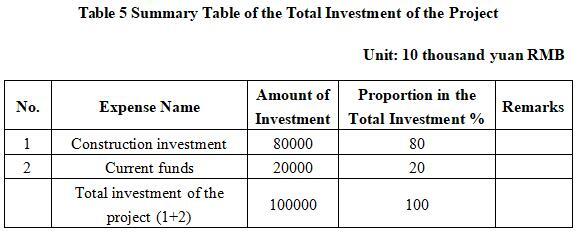
1.3.2 Capital raising
Self-funded by enterprises
1.4 Financial analysis and social evaluation
1.4.1 Main financial indexes
After the project reaches the production capacity, its annual sales income will be 600 million yuan, its profit will be 130 million yuan, its investment payback period will be 9.7 years (after the tax, including the construction period of 2 years) and its investment profit rate will be 13%.

Note: “10 thousand yuan” in the table is in RMB.
1.4.2 Social evaluation
Through the construction of the project, an industrial chain of raw material production, composite material processing, and industrial product manufacturing can be formed, and the R&D, production and application of new materials in Liaoyuan can be promoted. At the same time, it can drive the development of regional enterprises in related industries, provide employment opportunities, solve the employment of part of the labor force, and help maintain the prosperity and stability of society.
1.5 Cooperative way
Joint venture and cooperation, other ways are negotiable.
1.6 What to be invested by the foreign party
Funding, other ways are negotiable.
1.7 Construction site of the project
Longshan District, Liaoyuan City, Jilin Province.
1.8 Progress of the project
Foreign investment attraction.
2. Introduction to the Partner
2.1 Basic information
Name: Management Committee of Liaoyuan Longshan Industrial Development Zone.
Address: A lively street in Shoushan Town, Longshan District, Liaoyuan City, Jilin Province.
2.2 Overview
Founded in 2005, Liaoyuan Longshan Industrial Development (Concentration) Zone is a county-level industrial development zone approved by the Development Office of the Provincial Government, located in the eastern part of Liaoyuan City, with a total land area of 12.5 square kilometers. Among them, the planned area of the starting area is 2.38 square kilometers. According to the “Development and Construction Plan of Liaoyuan Longshan Industrial Development Zone” prepared, the industrial positioning with the production of new energy vehicles and parts R&D and manufacturing, new material R&D and manufacturing, modern logistics, medicine and health, and food processing industry as the core has been determined.
The development zone vigorously develops strategic emerging industries, actively develops strategic industries with development potential such as new energy auto parts, and cultivates new economic growth points; absorb the city's machinery and equipment, medicine and health enterprises that “retreat from the city and enter the district”. At the same time, it actively adopts high-tech transformation to upgrade traditional industries, increase product varieties, improve the industrial chain and supporting systems, improve the industrial technology level and value-added capabilities, and build and cultivate pillar industries in the area. Focusing on the needs of industrial support, resource advantages and consumer demand in the surrounding areas, we will vigorously develop new materials and new energy industry chains to create differentiated brands and characteristic products; Focus on the construction and development of the new material R&D and manufacturing industrial park in Longshan Industrial Development Zone; Focus on the introduction of tax sources, science and technology, and people's livelihood projects with high science and technology content, low energy consumption, low emissions, high added value, and significant economic and social benefits. At present, 80 enterprises (including escrow areas) have settled in the development zone, including 20 enterprises above the designated size.
2.3 Contact method
Postal code: 136299
Contact Person: Xing Tianbao
Tel: +86-437-3166166 +86-13904377816
E-mail: lyslsqswj@163.com
Contact method of the city (prefecture) where the project is located:
Contact unit: Liaoyuan Municipal Bureau of Commerce
Contact person: Ai Jing
Tel: +86-18643787709
E-mail: lyjhjxmc@163.com


